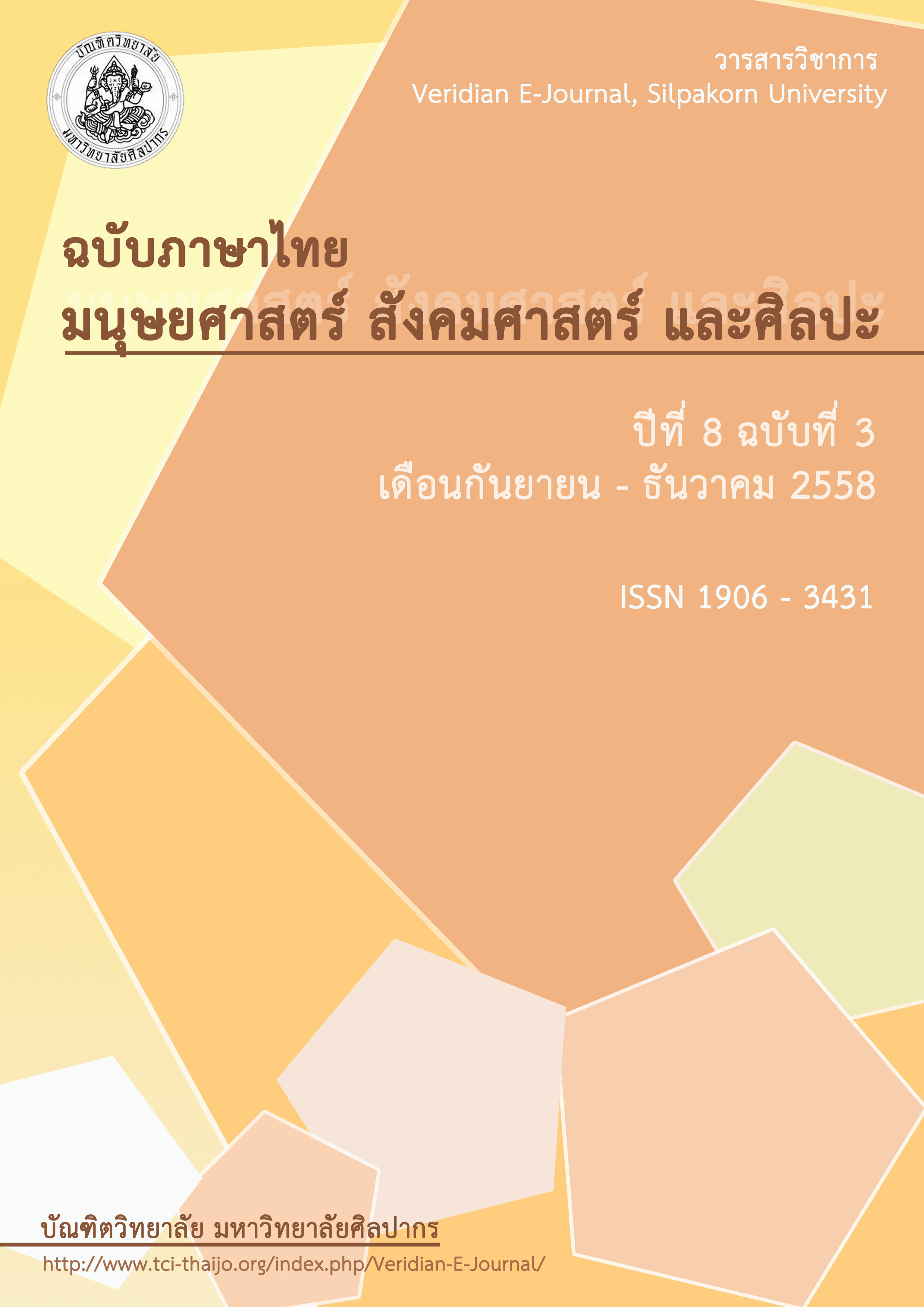แนวทางการเสริมสร้างสมานฉันท์โดยใช้กลไกอัตลักษณ์วัฒนธรรมปี่กลองมังคละ : ศึกษาเฉพาะกรณีชุมชนภาษาถิ่นสุโขทัย ลุ่นน้ำน่านตอนบน ในจังหวัดอุตรดิตถ์
Main Article Content
บทคัดย่อ
บทคัดย่อ
งานศึกษาเรื่องนี้มีวัตถุประสงค์ 1) เพื่อศึกษาการก่อเกิด และพัฒนาการของปี่กลองมังคละ 2)เพื่อศึกษาการแพร่กระจายของวัฒนธรรมปี่กลองมังคละ ในเขตพื้นที่ชุมชนภาษาถิ่นสุโขทัย เหนือสุดของลุ่มน้ำน่านตอนบน และ 3) เพื่อเสนอแนะแนวทางการเสริมสร้างสมานฉันท์โดยใช้กลไกอัตลักษณ์วัฒนธรรมปี่กลองมังคละในจังหวัดอุตรดิตถ์ รูปแบบการศึกษาเป็นการศึกษาเชิงคุณภาพ (Quanlitative Research) โดยศึกษาจากแหล่งข้อมูลที่เป็นเอกสารและแหล่งข้อมูลตัวบุคคลที่เป็นผู้ให้ข้อมูลที่สำคัญ จำนวน 11 คน พื้นที่ในการศึกษาจาก 2 ชุมชนหลัก ได้แก่ ชุมชนฝั่งขวาแม่น้ำน่าน เมืองทุ่งยั้งโบราณ (ซึ่งปรากฏในศิลาจารึกสุโขทัยหลักที่ 38 และ 49) ในเขตตำบลทุ่งยั้ง และตำบลไผ่ล้อม อำเภอลับแล จังหวัดอุตรดิตถ์ และชุมชนฝั่งซ้ายแม่น้ำน่าน เมืองสวางคบุรีโบราณ (ซึ่งปรากฏในศิลาจารึกสุโขทัยหลักที่ 3 และ 11) ในเขตตำบลผาจุก ตำบลคุ้งตะเภา และตำบลป่าเซ่า อำเภอเมือง จังหวัดอุตรดิตถ์ เครื่องมือที่ใช้ในการศึกษาคือแบบสัมภาษณ์แบบกึ่งโครงสร้าง การเก็บรวบรวมข้อมูลโดยวิธีการสัมภาษณ์แบบเจาะลึก (In-depth Interviews) และการสนทนากลุ่ม (Group Discussion) ตรวจสอบข้อมูลด้วยวิธีการแบบสามเส้า (Triangulation) และใช้วิธีการวิเคราะห์ข้อมูลเชิงเนื้อหาประกอบบริบท (Contextual Content Analysis)
ผลการศึกษาพบว่า 1) การก่อเกิด และพัฒนาการของดนตรีปี่กลองมังคละ แบ่งออกเป็น 2 ช่วง คือ (1) ช่วงดนตรีปี่กลองมังคละเริ่มปรากฏในอาณาจักรสุโขทัย (ปลายพุทธศตวรรษที่ 19) พร้อมกับการนำพระพุทธศาสนานิกายลังกาวงศ์จากลังกาเข้ามาในสมัยพระยาลิไท และ (2) ช่วงดนตรีปี่กลองมังคละปรากฏในธรรมเนียมของพระมหากษัตริย์สุโขทัย (ต้นพุทธศตวรรษที่ 20) จากการพบหลักฐานการถวายข้าพระไว้ประโคมมังคละเภรีสมโภชพระบรมธาตุ เฉกเช่นเดียวกับธรรมเนียมลังกา 2) การแพร่กระจายของวัฒนธรรมปี่กลองมังคละ ในเขตพื้นที่ชุมชนภาษาถิ่นสุโขทัยเหนือสุดของลุ่มน้ำน่านตอนบน (1) มีความสัมพันธ์กับการแพร่กระจายของดนตรีปี่กลองมังคละในอาณาจักรสุโขทัยโบราณ (พุทธศตวรรษที่ 20) จากการเกิดกระแสนิยมดนตรีปี่กลองมังคละของผู้คนในอาณาจักรสุโขทัยโบราณ โดยการค้นพบการแพร่กระจายของดนตรีที่เหมือนกับปี่กลองมังคละและมีความสัมพันธ์กับชุมชนภาษาถิ่นสุโขทัย คือ วงตุ๊บเก่ง ในจังหวัดเพชรบูรณ์ (ตะวันออกสุดของอาณาจักรสุโขทัย) และวงกาหลอ ในชุมชนภาษาไทยถิ่นใต้สำเนียงตากใบ (ใต้สุด) (2) ค้นพบการดำรงอยู่และล่มสลายของวัฒนธรรมปี่กลองมังคละในชุมชนภาษาถิ่นสุโขทัยเหนือสุดของลุ่มน่านตอนบน (พุทธศตวรรษที่ 20 – ปลายพุทธศตวรรษที่ 25) และ (3) ปัจจัยสำคัญที่ทำให้ดนตรีปี่กลองมังคละไม่ได้รับความนิยม จนทำให้ขาดผู้สืบทอดในระยะหลัง เนื่องมาจากการเข้ามาของดนตรีสมัยนิยม โดยการประยุกต์ปี่กลองมังคละ เป็นปี่กลองยาว (ราว พ.ศ. 2500 – พ.ศ. 2540) สำหรับ 3) แนวทางการเสริมสร้างสมานฉันท์โดยใช้กลไกอัตลักษณ์วัฒนธรรมปี่กลองมังคละในจังหวัดอุตรดิตถ์ ประกอบไปด้วยแนวทางวัฒนธรรมปี่กลองมังคละกับการสร้างความตระหนักรู้ในอัตลักษณ์ แนวทางอัตลักษณ์วัฒนธรรมปี่กลองมังคละกับการสร้างความสมานฉันท์ โดยใช้รูปแบบการสร้างเครือข่ายความดี และรูปแบบในการสร้างอัตลักษณ์ปฏิสัมพันธ์ เพื่อให้เกิด (1) การฟื้นฟูดนตรีปี่กลองมังคละให้กลับมามีบทบาท และเสริมสร้างให้เป็นอัตลักษณ์ท้องถิ่นหนึ่งของจังหวัดอุตรดิตถ์ ควรประยุกต์ใช้เพื่อให้ดนตรีปี่กลองมังคละเกิดการรับรู้ต่อชุมชนในฐานะดนตรีในพิธีกรรมศักดิ์สิทธิ์ทางพระพุทธศาสนา คณะสงฆ์และวัดในพื้นที่วัฒนธรรมปี่กลองมังคละดั้งเดิม ควรส่งเสริมให้มีการนำปี่กลองมังคละเป็นส่วนหนึ่งของกิจกรรมทางพระพุทธศาสนา และหน่วยงานราชการควรนำปี่กลองมังคละแสดงในกิจกรรมสำคัญของจังหวัด (2) การถ่ายทอดความรู้และส่งต่ออัตลักษณ์ปี่กลองมังคละอย่างเป็นระบบ ส่งเสริมสร้างหลักสูตรการเรียนการสอนดนตรีปี่กลองมังคละทั้งในสถานศึกษา และมหาวิทยาลัยในที่ตั้งจังหวัดอุตรดิตถ์ (3) หน่วยงานราชการระดับจังหวัดที่เกี่ยวข้อง ควรกำหนดในแผนการพัฒนา เพื่อจัดตั้งชมรมอนุรักษ์ดนตรีพื้นบ้านปี่กลองมังคละ โดยมุ่งให้องค์กรปกครองส่วนท้องถิ่น สภาวัฒนธรรม รวมทั้งสภาเด็กและเยาวชน เป็นหน่วยประสานงานเครือข่ายการอนุรักษ์และสืบทอดดนตรีปี่กลองมังคละในจังหวัดอุตรดิตถ์ ทั้งในระดับตำบลและอำเภอ อย่างเป็นระบบ ซึ่งแนวทางและข้อเสนอแนะดังกล่าว สามารถก่อให้เกิดอัตลักษณ์ท้องถิ่น ที่จะสามารถเสริมสร้างให้ชาวอุตรดิตถ์อยู่ร่วมกันด้วยความสมานฉันท์กลมเกลียว และเพื่อให้ดนตรีปี่กลองมังคละดำรงอยู่ และสร้างความภาคภูมิใจในอัตลักษณ์ทางวัฒนธรรมมรดกโลก ให้แก่ชาวจังหวัดอุตรดิตถ์ได้อย่างยั่งยืน
คำสำคัญ : การสร้างสมานฉันท์, ชุมชนภาษาถิ่นสุโขทัย, อัตลักษณ์วัฒนธรรม, กลองมังคละ, ศิลปะพื้นบ้าน
ABSTRACT
The objectives of this research were 1) to study the origin and evolution of Mangkla band, 2) to study the cultural spread of Mangkla band in Sukhothai dialect communities in Nan upper watershed, and to suggest approach to harmony promotion through cultural identity mechanism of Mangkla band in Uttaradit province. This study was quanlitative research. Data were collected from related documents and 11 key informants. The setting was two main communities, i.e. , a community in right bank of the Nan River, Thung Yang ancient city, which appeared in Sukhothai stone inscription no. 38 and 49 (in Thung Yang and Pailom subdistricts, Lub Lae district, Uttaradit Province) and a community in left bank of the Nan River, Sawangkhaburi ancient city, which appeared in Sukhothai stone inscription no. 3 and 11 (in Phajuk, Kung Tapao, and Pasao, Muaeng district, Uttaradit province). The instrument used in the study was a semi-structured interview. The data were collected by using in-depth interviews and group discussion. Data were verified by the Triangulation and analyzed by contextual content analysis technique.
The results of this study found that: 1) The origin and development of Mangkla musical band can be divided into two phases: (1) the emergence of Mangkla band in Sukhothai Kingdom (late 19thBuddhist Era), along with the introduction of Sinhalese(Lungkawong) Buddhism from Ceylon during Phraya Lithai era. (2) the emergence of Mangkla band in traditions during Sukhothai era( early 20th Buddhist Era), as evidenced by the King of Sukhothai offered servants for celebrating Buddha's relics, the similar tradition of Ceylon. 2) In terms of the spread of Mangkla band culture in Sukhothai dialect communities in Nan upper watershed, the study found that: (1) such spread was related to the spread of mangkla band during the ancient kingdom of Sukhothai (20th Buddhist Era) from the popularity of Mangkla band in the ancient kingdom of Sukhothai. Other bands relating to Mangkla band and Suklothai dialect communities were Tubkeng band in Phetchabun. (East end of the Sukhothai Kingdom) and Kalho band in Takbai dialect communities(South end). (2) the existence and destruction of Mangkla band culture in Sukhothai dialect communities in Nan upper watershed (20th Buddhist Era - late 25th Buddhist Era) was discovered. (3) Factor causing the obsoleteness and unpopularity of Mangkla band was the emergence of modern music and the application of Mangkla band to Long Drum band (B.E. 2500 – B.E. 2540). 3) The followings are approaches to harmony promotion through cultural identity mechanism of Mangkla band in Uttaradit province. To renew Mangkla band and enhance its role and identity in Uttaradit province, the awareness of Mangkla band among local communities should be built by considering it as important musical band in Buddhist ritual. The knowledge and identity of Mangkla band should be systematically passed on and transferred. Government agencies should establish Committee and Mangkla band conservative club to coordinate the Mangkla conservation and inherit among members of Mangkla band network in Uttaradit province, to improve Mangkla band course and education in educational institutions in Uttaradit province as well as local administration organization, children and youth council at subdistrict level. Such education should link to local ethnic and history. Moreover, government agencies should hold Mangkla band show in important events in Uttaradit province. Local temples should promote the use of Mangkla band as part of religious activities. The above approaches are consistent to States of Conciliation (Saraniyadhamma) in Buddhism. In particular, they are consistent to Sadharana-bhogi( to share any lawful gains with virtuous fellows), Sila-samannata (to keep without blemish the rules of conduct along with one’s fellows, openly and in private), and Ditthi-samannata( to be endowed with right views along with one’s fellows, openly and in private), which generate local identity, strengthen the harmony among local people in Uttaradit, sustain Mangkla band, and build pride in cultural identity of world heritage to Uttaradit people in sustainable manner.
Keywords: Harmony building, Sukhothai dialect Community, Cultural identity, Mangkla drum, Folk art

